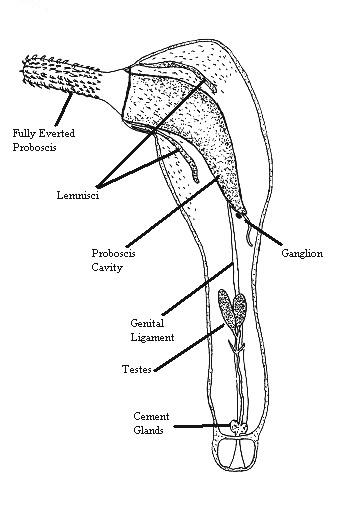|
Acanthocephala
Acanthocephala (Greek , ', thorn + , ', head) is a phylum of parasitic worms known as acanthocephalans, thorny-headed worms, or spiny-headed worms, characterized by the presence of an eversible proboscis, armed with spines, which it uses to pierce and hold the gut wall of its host. Acanthocephalans have complex life cycles, involving at least two hosts, which may include invertebrates, fish, amphibians, birds, and mammals. About 1420 species have been described. The Acanthocephala were thought to be a discrete phylum. Recent genome analysis has shown that they are descended from, and should be considered as, highly modified rotifers. This unified taxon is known as Syndermata. History The earliest recognisable description of Acanthocephala – a worm with a proboscis armed with hooks – was made by Italian author Francesco Redi (1684).Crompton 1985, p. 27 In 1771, Joseph Koelreuter proposed the name Acanthocephala. Philipp Ludwig Statius Müller independently called ... [...More Info...] [...Related Items...] OR: [Wikipedia] [Google] [Baidu] |
Archiacanthocephala
Archiacanthocephala is a class within the phylum of Acanthocephala. They are parasitic worms that attach themselves to the intestinal wall of terrestrial vertebrates, including humans. They are characterised by the body wall and the lemnisci (which are a bundle of sensory nerve fibers), which have nuclei that divide without spindle formation, or the appearance of chromosomes, or it has a few amoebae-like giant nuclei. Typically, there are eight separate cement glands in the male, which is one of the few ways to distinguish the dorsal and ventral sides of these organisms. Taxonomy Genetic data are not available for the genus ''Apororhynchus'' in public databases, and ''Apororhynchus'' has not been included in phylogenetic analyses thus far due to insufficiency of morphological data. However, the lack of features such as an absence of a muscle plate, a midventral longitudinal muscle, lateral receptacle flexors, and an apical sensory organ when compared to the other three orders o ... [...More Info...] [...Related Items...] OR: [Wikipedia] [Google] [Baidu] |
Eoacanthocephala
Eoacanthocephala is a class of parasitic worms, within the phylum Acanthocephala. They feed on any aquatic cold-blooded creature such as turtles and fish. Their proboscis spines are arranged radially, with no protonephridia, and with persistent ligament sacs in female. The only reliable way to identify the group is that they only have one cement gland. This is a primitive characteristic and hence the name. The class contains 2 orders Order, ORDER or Orders may refer to: * Categorization, the process in which ideas and objects are recognized, differentiated, and understood * Heterarchy, a system of organization wherein the elements have the potential to be ranked a number of ...: * Gyracanthocephala Van Cleave, 1936 * Neoechinorhynchida Southwell and Macfie, 1925 References *Robert L. Usinger; Storer. 1951. General Zoology. Sixth edition. McGraw-Hill, Inc. Page-437.ITIS - Report: Eoacanthocephala".''www.itis.gov''. Retrieved 2022-10-15. Acanthocephalans {{A ... [...More Info...] [...Related Items...] OR: [Wikipedia] [Google] [Baidu] |
Palaeacanthocephala
Palaeacanthocephala ("ancient thornheads") is a class within the phylum Acanthocephala. The adults of these parasitic platyzoans feed mainly on fish, aquatic birds and mammals. This order is characterized by the presence of lateral longitudinal lacunar canals and a double-walled proboscis receptacle. The nuclei of the hypodermis (outer layer of skin) are fragmented and the males have two to seven cement glands, unlike their relatives the Archiacanthocephala, which always have eight. There are three orders in the class Palaeacanthocephala: * Echinorhynchida Southwell and Macfie, 1925 * Heteramorphida Amin and Ha, 2008 * Polymorphida Polymorphida are an order of thorny-headed worms (phylum Acanthocephala). The adults of these parasitic platyzoans feed mainly on fish and aquatic birds. This order contains 5 families:Huston, D. C., Cribb, T. H., & Smales, L. R. (2020). Molec ... Petrochenko, 1956 References Acanthocephalans {{Acanthocephalan-stub ... [...More Info...] [...Related Items...] OR: [Wikipedia] [Google] [Baidu] |
Polyacanthocephala
Polyacanthorhynchidae is a family of parasitic worms from the (phylum Acanthocephala). It contains a single genus ''Polyacanthorhynchus''. Taxonomy Phylogenetic analysis has found that polyacanthocephala represents a distinct class of acanthocephalans. Species There are four species in the genus Polyacanthorhynchus . * ''Polyacanthorhynchus caballeroi'' Diaz-ungria and Rodrigo, 1960 The complete genome of the mitochondria has been determined. ''P. caballeroi'' infect South American caimans. * ''Polyacanthorhynchus echiyensis * ''Polyacanthorhynchus kenyensis'' Schmidt and Canaris, 1967 ''P. kenyensis'' has been found infecting three freshwater teleosts: the Blue spotted tilapia (''Oreochromis leucostictus''), the Redbelly tilapia (''Tilapia zillii''), and the Largemouth bass (''Micropterus salmoidein'') in Lake Naivasha, Kenya. Samples were found in the liver of ''Tilapia'' and ''Orechromis'' and free in the body cavity in ''Micropterus''Description of morphology available ... [...More Info...] [...Related Items...] OR: [Wikipedia] [Google] [Baidu] |
Corynosoma Wegeneri
''Corynosoma'' is a genus of parasitic worms belonging to the family Polymorphidae. The genus has almost cosmopolitan distribution. Species: *''Corynosoma alaskensis'' *''Corynosoma australe'' *''Corynosoma beaglense'' *''Corynosoma bullosum'' *''Corynosoma cameroni'' *''Corynosoma caspicum'' *''Corynosoma cetaceum'' *''Corynosoma curilense'' *''Corynosoma enhydri'' *''Corynosoma erignathi'' *''Corynosoma evae'' *''Corynosoma falcatum'' *''Corynosoma gibsoni'' *'' Corynosoma hamanni'' *''Corynosoma hannae'' *''Corynosoma magdaleni'' *''Corynosoma pseudohamanni'' *'' Corynosoma rauschi'' *'' Corynosoma reductum'' *'' Corynosoma semerme'' *'' Corynosoma septentrionale'' *'' Corynosoma shackletoni'' *'' Corynosoma simile'' *'' Corynosoma stanleyi'' *'' Corynosoma strumosum'' *'' Corynosoma validum'' *'' Corynosoma ventronudum'' *''Corynosoma villosum ''Corynosoma'' is a genus of parasitic worms belonging to the family Polymorphidae. The genus has al ... [...More Info...] [...Related Items...] OR: [Wikipedia] [Google] [Baidu] |
Rotifer
The rotifers (, from the Latin , "wheel", and , "bearing"), commonly called wheel animals or wheel animalcules, make up a phylum (Rotifera ) of microscopic and near-microscopic pseudocoelomate animals. They were first described by Rev. John Harris in 1696, and other forms were described by Antonie van Leeuwenhoek in 1703. Most rotifers are around long (although their size can range from to over ), and are common in freshwater environments throughout the world with a few saltwater species. Some rotifers are free swimming and truly planktonic, others move by inchworming along a substrate, and some are sessile, living inside tubes or gelatinous holdfasts that are attached to a substrate. About 25 species are colonial (e.g., ''Sinantherina semibullata''), either sessile or planktonic. Rotifers are an important part of the freshwater zooplankton, being a major foodsource and with many species also contributing to the decomposition of soil organic matter. Most species of the r ... [...More Info...] [...Related Items...] OR: [Wikipedia] [Google] [Baidu] |
Parasitic
Parasitism is a close relationship between species, where one organism, the parasite, lives on or inside another organism, the host, causing it some harm, and is adapted structurally to this way of life. The entomologist E. O. Wilson has characterised parasites as "predators that eat prey in units of less than one". Parasites include single-celled protozoans such as the agents of malaria, sleeping sickness, and amoebic dysentery; animals such as hookworms, lice, mosquitoes, and vampire bats; fungi such as honey fungus and the agents of ringworm; and plants such as mistletoe, dodder, and the broomrapes. There are six major parasitic strategies of exploitation of animal hosts, namely parasitic castration, directly transmitted parasitism (by contact), trophicallytransmitted parasitism (by being eaten), vector-transmitted parasitism, parasitoidism, and micropredation. One major axis of classification concerns invasiveness: an endoparasite lives inside the host's ... [...More Info...] [...Related Items...] OR: [Wikipedia] [Google] [Baidu] |
Joseph Koelreuter
Joseph is a common male given name, derived from the Hebrew Yosef (יוֹסֵף). "Joseph" is used, along with "Josef", mostly in English, French and partially German languages. This spelling is also found as a variant in the languages of the modern-day Nordic countries. In Portuguese and Spanish, the name is "José". In Arabic, including in the Quran, the name is spelled '' Yūsuf''. In Persian, the name is "Yousef". The name has enjoyed significant popularity in its many forms in numerous countries, and ''Joseph'' was one of the two names, along with ''Robert'', to have remained in the top 10 boys' names list in the US from 1925 to 1972. It is especially common in contemporary Israel, as either "Yossi" or "Yossef", and in Italy, where the name "Giuseppe" was the most common male name in the 20th century. In the first century CE, Joseph was the second most popular male name for Palestine Jews. In the Book of Genesis Joseph is Jacob's eleventh son and Rachel's first son, and ... [...More Info...] [...Related Items...] OR: [Wikipedia] [Google] [Baidu] |
Genome
In the fields of molecular biology and genetics, a genome is all the genetic information of an organism. It consists of nucleotide sequences of DNA (or RNA in RNA viruses). The nuclear genome includes protein-coding genes and non-coding genes, other functional regions of the genome such as regulatory sequences (see non-coding DNA), and often a substantial fraction of 'junk' DNA with no evident function. Almost all eukaryotes have mitochondria and a small mitochondrial genome. Algae and plants also contain chloroplasts with a chloroplast genome. The study of the genome is called genomics. The genomes of many organisms have been sequenced and various regions have been annotated. The International Human Genome Project reported the sequence of the genome for ''Homo sapiens'' in 200The Human Genome Project although the initial "finished" sequence was missing 8% of the genome consisting mostly of repetitive sequences. With advancements in technology that could handle seq ... [...More Info...] [...Related Items...] OR: [Wikipedia] [Google] [Baidu] |
Syndermata
Syndermata is a clade of animals that, in some systems, is considered synonymous with Rotifera. Older systems separate Rotifera and Acanthocephala Acanthocephala (Greek , ', thorn + , ', head) is a phylum of parasitic worms known as acanthocephalans, thorny-headed worms, or spiny-headed worms, characterized by the presence of an eversible proboscis, armed with spines, which it uses to p ... as different phyla, and group them both under Syndermata. References Platyzoa {{Protostome-stub ... [...More Info...] [...Related Items...] OR: [Wikipedia] [Google] [Baidu] |
Francesco Redi
Francesco Redi (18 February 1626 – 1 March 1697) was an Italian physician, naturalist, biologist, and poet. He is referred to as the "founder of experimental biology", and as the "father of modern parasitology". He was the first person to challenge the theory of spontaneous generation by demonstrating that maggots come from eggs of flies. Having a doctoral degree in both medicine and philosophy from the University of Pisa at the age of 21, he worked in various cities of Italy. A rationalist of his time, he was a critic of verifiable myths, such as spontaneous generation. His most famous experiments are described in his magnum opus ''Esperienze intorno alla generazione degl'insetti'' (''Experiments on the Generation of Insects''), published in 1668. He disproved that vipers drink wine and could break glasses, and that their venom was poisonous when ingested. He correctly observed that snake venoms were produced from the fangs, not the gallbladder, as was believed. He ... [...More Info...] [...Related Items...] OR: [Wikipedia] [Google] [Baidu] |
Karl Rudolphi
Karl Asmund Rudolphi (14 July 1771 – 29 November 1832) was a Swedish-born German naturalist, who is credited with being the "father of helminthology". Life Rudolphi was born in Stockholm to German parents. He was awarded his PhD in 1793 and his medical doctorate in 1794 from the University of Greifswald, where he was appointed Professor of Anatomy. He worked widely across the fields of botany, zoology, anatomy and physiology. He investigated the anatomy of nerves, carried out studies of plant growth and was an early champion of the view that the cell is the basic structural unit of plants. In 1804, Karl Rudolphi, along with J.H.F. Link were awarded the prize for "solving the problem of the nature of cells" by the Königliche Societät der Wissenschaft (Royal Society of Science), Göttingen, for proving that cells had independent rather than common walls. His first great publication was a study of parasitic worms, the ''Enterozoorum Sive Vermium Intestinalium Historia Na ... [...More Info...] [...Related Items...] OR: [Wikipedia] [Google] [Baidu] |



